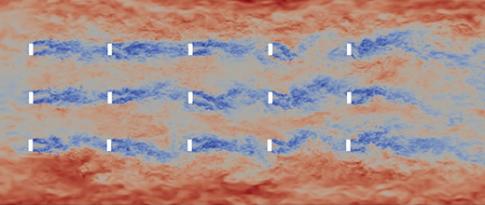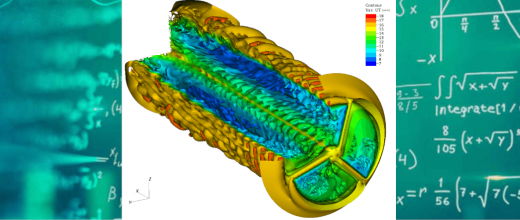In the field of wind energy, Large Eddy Simulations (LES1) are widely used to gain a better understanding of wind flow within wind farms. On a wind farm scale, they are also used to establish analytical wake models, and are useful for studying the interactions between individual wind turbines as well as with the atmospheric boundary layer (ABL). However, existing computing resources do not enable a sufficiently detailed resolution of these models2 while carrying out associated simulations within acceptable periods of time.
To reduce this calculation cost, researchers already use actuator methods [1], for example, to model blades using the body forces3 technique (actuator lines and actuator disks). This makes it possible to limit the mesh size while not explicitly representing blade geometry. However, while significant, the reduction in calculation time associated with LES is not yet sufficient for the detailed numerical simulation of a windfarm.
In practice, such simulation needs to consider the interaction between phenomena occurring on a kilometer scale (atmospheric phenomena) and a meter scale (effects of wake turbulence). It is this constraint that leads to costly simulations, particularly with traditional LES solvers4.
As an alternative to these solvers, IFPEN decided to study the use of the Lattice-Boltzmann Method (LBM), accelerated by using graphics cards (GPU5). Indeed, while founded on theoretical bases different from LES, LBM can solve equivalent problems and solvers based on this method are more efficient and particularly suited to massively parallel heterogeneous computing architectures.
This research was conducted within the framework of the European EoCoE-II project, completed at the end of 2022, in collaboration with the developers of the massively parallel solver waLBerla6, at Erlangen University. On this basis, IFPEN developed the waLBerla-wind solver for two microprocessor architectures (x86 and ARM). Due to its unique software design, which provides a common code base for CPU and GPU, the portability of the different target architectures is ensured, with a reduced maintenance cost. Moreover, this solver is compatible with NVIDIA’s GPUDirect® technology for efficient data transfer between several GPUs.
As with LES, the physical models deployed in waLBerla-wind to simulate wind turbines use actuator methods, with optional end-of-blade load loss corrections. This solver can also be used to simulate different wind turbine configurations, both horizontally and vertically.
The numerical results and calculation performance of waLBerla-wind were compared [2] with those of SOWFA, the most widely used LES solver in wind energy research, and Meso-NH, a tool co-developed by IFPEN and Meteo France, based on a meteorological solver developed by the CNRM7.
The comparison is related to a relatively simple test case, with a single turbine, applying the same time step and the same mesh size for the three solvers.
It turned out that with CPUs alone, and for the same number of compute nodes, the waLBerla-wind LBM solver was 70 times faster than SOWFA and 40 times faster than Meso-NH. Using GPUs as well for the LBM solver (Figure 1), the ratios were even more remarkable: 470 and 290 respectively, while producing comparable results (Figure 2).
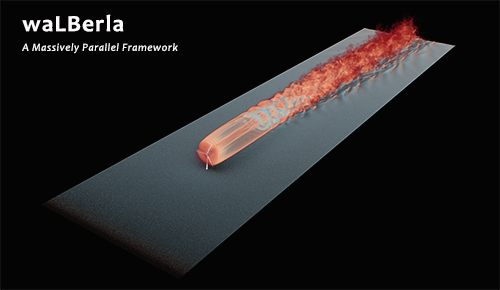
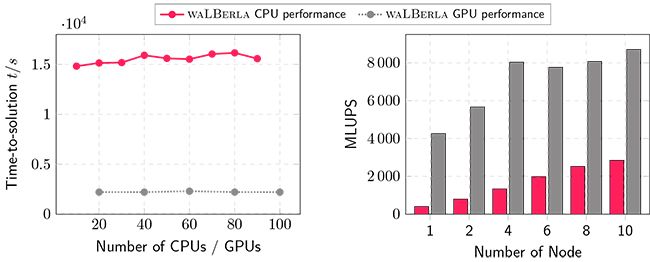
and influence of parallel computing on the computing performance at this scale (graphs above)
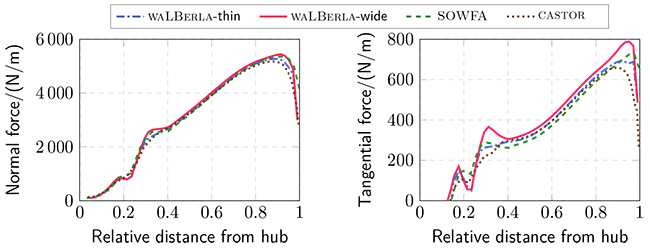
The massive parallelism deployed in waLBerla-wind gives this code the capacity to efficiently simulate not only individual turbines but also entire wind farms. The most remarkable aspect is that combining the use of the LBM method with massively parallel computing on GPUs makes it possible to envisage real-time simulations.
Work to enhance the software to consider the atmospheric boundary layer (ABL) phenomenon is currently underway in the context of PhD research* aimed at simulating wind farms in even more realistic conditions.
1- Mathematical turbulence model used in numerical fluid dynamics.
2- See Science@ifpen issue 49.
3- Forces acting throughout the entire volume of a body.
4- Based on Navier-Stokes equations.
5- Graphics Processing Unit, vs Central Processing Unit (CPU).
6- This open-source solver is currently one of the most efficient that exists thanks, in particular, to the use of high-performance code generation techniques.
7- Centre National de Recherches Météorologiques (French Meteorological Research Center, Météo France).
* Thesis entitled: Lattice Boltzmann methods for windfarm application: aeroelastic wind turbine modeling in an atmospheric boundary layer.
References:
-
Pierre-Antoine Joulin, Fine-scale modeling of the interactions between wind farms and local weather conditions, PhD thesis
>> https://www.theses.fr/2019INPT0135 -
Helen Schottenhamml, Ani Anciaux-Sedrakian, Frédéric Blondel, Adria Borras-Nadal, Pierre-Antoine Joulin, and Ulrich Rüde. Evaluation of a lattice Boltzmann-based wind-turbine actuator line model against a Navier-Stokes approach. Journal of Physics: Conference Series, 2265(2):022027, May 2022.
>> https://hal-ifp.archives-ouvertes.fr/hal-03750519/document
Scientific Contacts: helen.schottenhamml@ifpen.fr ; Ani Anciaux Sedrakian ; frederic.blondel@ifpen.fr
You may also be interested in
Wind farm optimization: in the wake of modeling advances
Wind energy accounts for an increasing share of the energy mix thank to the construction of wind farms designed to reduce investment and operating costs. However, within a farm, downstream wind turbines are exposed to the wakes of upstream rotors, leading to a reduction in their production and an increase in their fatigue stresses...






